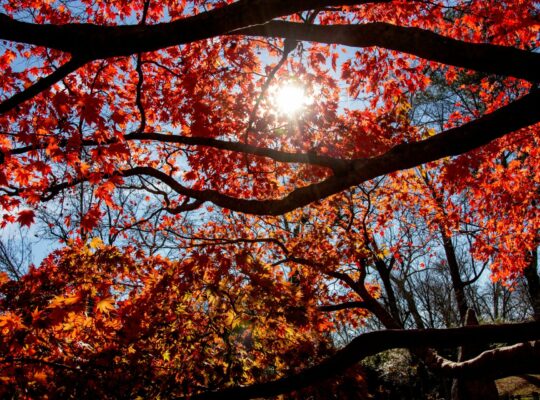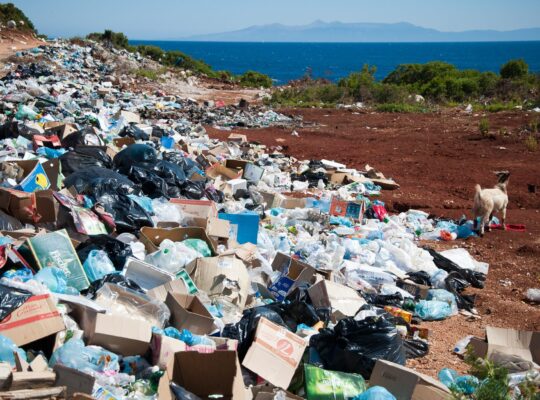Hanging with Hundreds of Polar Bears
Guest post by: Alysa McCall, Polar Bears International Director of Conservation Outreach and Staff Scientist
Hundreds of polar bears are gathering around Hudson Bay right now. I’m thrilled to be back in Churchill, Canada — known as the polar bear capital of the world — for this year’s migration. Polar bears are usually solitary, so this gathering is a spectacular sight to behold.
As we begin this year’s bear season in Churchill, the weather has been unseasonably warm, with a hint of fall color remaining on the tundra. We already have the Tundra Buggies® roaming on their trails and the explore.org live cams rolling alongside the polar bears as they wait for the bay to freeze. They always gather here each fall as it starts getting chilly, knowing that once sea ice forms, they can stop fasting and head out on the ice to resume hunting their seal prey.
The live cams have been spotting some sweet moms and cubs snuggling and taking naps on windy days, and there have even been some glimpses of a mom nursing her cub. We’ve been seeing more and more polar bears, including a nice view of a female bear swimming off Gordon Point. We don’t often get to see the bears swimming in the fall, so this was a delight to observe. She spent quite some time with the buggies before moving on to settle in some nearby willows. Bear sightings and activity will increase even more as temperatures drop and the bears head to the coast, anticipating the freeze-up on Hudson Bay.

We honor the annual migration with Polar Bear Week (October 31 – November 6), celebrating the bears and raising awareness about the challenges they face in a warming Arctic. This year we’re kicking off Polar Bear Week with something totally new — a concert! We’re excited to live stream a concert with renowned singer, multi-instrumentalist, and songwriter Kishi Bashi from Tundra Buggy® One, our education and broadcast vehicle, surrounded by polar bears and the dancing hues of the setting sun. After the performance, I’ll be chatting with Kishi all about polar bears. We’ll even have Max Lowe, who’s a National Geographic photographer, on board documenting the special afternoon. We invite everyone to enjoy it this Wednesday, October 27, at 4:30 pm EST — just RSVP here.

Once Polar Bear Week gets into full swing, we encourage you to keep watching the live cams, as the wildlife activity always surprises us. In the past, we have seen wolverines, red foxes, male polar bears sparring, and even a mother polar bear with triplet cubs. Follow along and play bingo with this card, and you can win a prize from explore.org. Plus, I’ll be hosting lots of Tundra Connections live chats from Tundra Buggy® One, where myself and other polar bear experts can answer your questions in real-time.

This year, Polar Bear Week coincides with the COP26 UN Climate Summit in Glasgow, Scotland. We’ll have some representatives there, and we’re excited to be connecting dots between the polar bears, politicians, and people around the world. There are so many ways to help the bears and create a better Earth for polar bears and people alike. Many of the changes needed are at the policy level, but we can all play a role in making that happen. If you want to get involved, here are a few things you can do:
- You can talk about climate change and why it matters to you with your friends, family, and colleagues. By making climate change part of everyday conversations, you’ll help make it a kitchen table issue and a policy priority.
- You can get involved with community projects that will help make a difference on a scale beyond your own household (because individual actions alone won’t get us where we need to be). This might mean advocating for electric buses, working with schools on no-idle zones, or supporting local bike lanes, farmers’ markets, and renewable-energy initiatives.
- You can vote with the climate in mind, in each and every election, at every level of government—because we need policy changes to create sustainable systems. You can also regularly contact your representatives in support of climate action. And you can encourage your friends, family, and neighbors to join you in getting involved.
- You can follow a conservation ethic in your own life, whether it’s switching to a clean energy source (most utility companies offer this option), supporting companies that are taking meaningful steps to lower their emissions, or helping to bring about a shift to sustainable food systems by shopping at your local farmers’ market—and then talk about these choices with others, helping to make a climate-friendly living a social norm.
- And finally, you can donate in support of Polar Bears International’s efforts. This year, we’re launching a campaign to fund the development of “Detect and Protect” radar systems (affectionately known by us as “Bear-dar”) to alert communities of approaching bears. Our goal is to reduce conflict between polar bears and people—keeping both from harm. You can donate here or even take part in the Detect and Protect Polar Bears Challenge by hosting your own fundraiser!

During the migration, we’re watching and studying the Western Hudson Bay population of polar bears. I’ve been studying this population in particular for nearly my whole career. In fact, my thesis at the University of Alberta focused on the polar bears of Western Hudson Bay. Sadly, this population has experienced a 30% decline since the early 1980s. The summer ice-free period is three to four weeks longer than it was in the 1980s, meaning the bears are on land and fasting for longer. This leads to more human-bear interaction. Thus, we’ve been supporting Churchill in establishing the world’s first polar bear safe community, which minimizes encounters between people and polar bears so both can thrive. The great thing about polar bears is that they live a long time — so if our leaders act quickly to reduce greenhouse gas emissions, we have an opportunity to preserve polar bears for future generations to come.
We’re working to understand and safeguard the world’s polar bears with cutting-edge technology and climate research solutions. For example, we’ve been working with 3M on developing “Burr on Fur” tracking devices — what started as an internal company challenge on a better way to tag a polar bear blossomed into several prototypes of small tracking devices that can be attached to a polar bear’s fur. The devices must be able to withstand Arctic temperatures, saltwater, snow, and abrasions (caused by polar bears rolling in the snow, etc.) Last fall, we began testing the devices on wild polar bears in the Western Hudson Bay population and then expanded to bears in zoo settings. This season we’ve been expanding the initiative, and tagging wild polar bears in Southern Hudson Bay, in partnership with Environment and Climate Change Canada, York University, and the Ontario Ministry of Natural Resources.
If you have a keen eye, you might spot a new proof-of-concept, zero-emission electric vehicle Tundra Buggy®, roaming (very quietly) along the icy shores. Our friends at Frontiers North Adventures are behind the EV Tundra Buggy®, as well as Buggy One, Polar Bears International’s legendary research vehicle. Buggy One is my home away from home this time of year, and hopefully I’ll catch some of you during the Tundra Connections live chats. Thanks for following along, and cheers to a beautiful migration.











